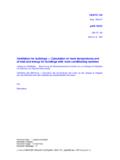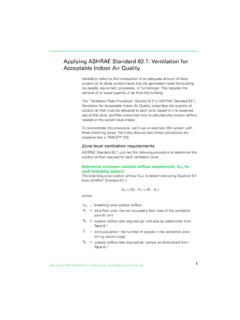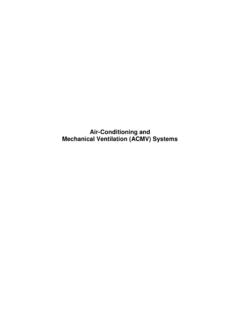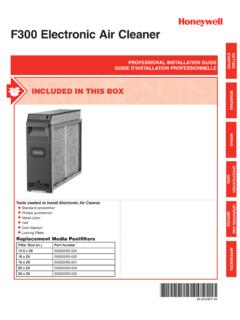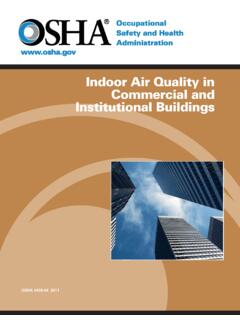Transcription of Ventilation for buildings — Calculation methods for the ...
1 Document type: European Standard Document subtype: Document stage: Formal Vote Document language: E J:\Intcom\CEN\CEN 156\prEN 15242\prEN STD Version CEN/TC 156 Date: 2006 prEN 15242 CEN/TC 156 Secretariat: BSI Ventilation for buildings Calculation methods for the determination of air flow rates in buildings including infiltration ICS: Descriptors: prEN 15242:2006 (E) 2 Contents Page Foreword .. 4 Introduction .. 5 1 7 2 Normative references .. 7 3 Terms and 8 4 Symbols and abbreviations .. 10 5 General 11 6 Instantaneous Calculation (iterative method).. 14 Basis of the Calculation method .. 14 Mechanical air flow Calculation .. 15 Introduction .. 15 required air flow qv-sup-req and qv-exh 15 Cuse 15 Ventilation effectiveness 15 Local air flow control Coefficient 16 Csyst coefficient .. 16 Duct leakagecoefficient 16 AHU leakage coefficient 16 Indoor and outdoor leakage Coefficient.
2 17 Recirculation Coefficient 17 Mechanical air flow to the zone qv supply qv 17 Mechanical air flow to the AHU .. 17 Passive and hybrid duct 19 Cowl air flow .. 20 Duct .. 25 Overall Calculation .. 25 Combustion air flows,.. 25 Air flow due to windows opening .. 27 Airing .. 27 Air flow for summer 28 Typical use of windows 29 Exfiltration and infiltration using iterative 29 Cp values .. 29 Pressure difference for each external envelope component .. 29 Description of external envelope component .. 30 Calculation of infiltred and exflitred air flows .. 30 Exflitration and infiltration Calculation using direct 30 Determination of average flow values .. 31 7 32 Energy .. 32 General requirements .. 32 conventional and default values .. 32 air flows 35 Heating Zone and room 37 General 37 other 37 Cooling loads.
3 37 prEN 15242:2006 (E) 3 Summer comfort .. 37 Indoor air quality .. 38 Annex A (normative) Data on wind pressure coefficients .. 39 Annex B (normative) Leakages characteristics .. 45 Expression of national requirements and default values .. 45 Examples of application .. 45 Annex C (normative) Calculation of recirculation coefficient Crec .. 48 Annex D (normative) Conversion formulas .. 50 l/s vs m3 50 Mass flow rate vs volume flow 50 For leakages .. 50 For air inlets,.. 50 For fan .. 50 Calculation of Cleak and Cvent .. 50 Annex E (informative) Informative references .. 53 Annex F (informative) examples of Fuel flow factor for residential buildings .. 54 prEN 15242:2006 (E) 4 Foreword This document prEN 15242 has been prepared by Technical Committee CEN/TC 156 Ventilation for buildings , the secretariat of which is held by BSI. This document is currently submitted to the Formal Vote.
4 This document has been prepared under a mandate given to CEN by the European Commission and the European Free Trade Association, and supports essential requirements of EU Directive 2002/91/EC. prEN 15242:2006 (E) 5 Introduction This standard defines the way to calculate the airflows due to the Ventilation system and infiltration. The relationships with some other standards are as follows: 137921524215203- 15315 ;152171524113790152431377915251 Figure 1 scheme of relationship between standards from To Information transferred variables 15251 15243 Indoor climate requirements Heating and cooling Set points 13779 15251 15242 Airflow requirement for comfort and health required supply and exhaust Air flows 15242 15241 Air flows Air flows entering and leaving the building 15241 13792 Air flows Air flow for summer comfort Calculation 15241 15203- 15315 ;15217 energy Energies per energy carrier for Ventilation (fans, humidifying, precooling, pre heating), + heating and cooling for air systems 15241 13790 data for heating and cooling Calculation Temperatures, humilities and flows of air entering the building 15243 15243 Data for air systems required energies for heating and cooling 15243 15242 Data for air heating and cooling systems required airflows when of use 15243 13790 data for building heating and cooling Calculation Set point, emission efficiency, distribution recoverable losses, generation recoverable losses 13790 15243 Data for system Calculation required energy for generation prEN 15242:2006 (E) 6 Pren titles are.
5 15217 methods for expressing energy performance and for energy certification of buildings 15203 15315 Overall energy use and definition of energy ratings 15243 room temperatures, load and energy for buildings with room conditioning systems 13790 energy use for space heating and cooling Simplified method 15242 determination of air flow rates in buildings including infiltration 15241 energy requirements due to Ventilation systems in buildings 13779 Ventilation for non residential buildings Performance requirements for Ventilation and room conditioning systems.* 13792 Calculation of internal temperatures in summer of a room without mechanical cooling simplified methods 15251 Specification of criteria for the internal environment (thermal, lighting, indoor air quality) The Calculation of the airflows through the building envelope and the Ventilation system for a given situation is first described (chapter 6).
6 Applications depending on the entended uses are described in chapter 7. The target audience of this standard is policy makers in the building regulation sector, software developers of building simulation tools, industrial and engineering companies. prEN 15242:2006 (E) 7 1 Scope This European standard describe the method to calculate the Ventilation air flow rates for buildings to be used for applications such as energy calculations, heat and cooling load Calculation , summer comfort and indoor air quality evaluation. The Ventilation and air tightness requirements (as IAQ, heating and cooling, safety, fire ) are not part of the standard. For these different applications, the same iterative method is used but the input parameter has to be selected according to the field of application. For specific applications a direct Calculation is also defined in this standard.
7 A simplified approach is also allowed at national level following prescribed rules of implementation. The method is meant to be applied to : Mechanically ventilated building (mechanical exhaust, mechanical supply or balanced system). Passive ducts. Hybrid system switching between mechanical and natural modes. Windows opening by manual operation for airing or summer comfort issues. Automatic windows (or openings) are not directly considered here. Industry process Ventilation is out of the scope. Kitchen where cooking is for immediate use are part of the standards (including ) Other Kitchens are not part of the standard The standard is not directly applicable for buildings higher than 100m and rooms where vertical air temperature difference is higher than 15K The results provided by the standard are the building envelope flows either through leakages or purpose provided openings and the air flows due to the Ventilation system, taking into account the product and system characteristics.
8 2 Normative references This draft incorporates by dated or undated reference, provisions from other publications. These normative references are cited at the appropriate places in the text and the publications are listed hereafter. For dated references, subsequent amendments to or revisions of any of these publications apply to this draft only when incorporated in it by amendment or revision. For undated references the latest edition of the publication referred to applies. prEN 1507, Ventilation for buildings Rectangular sheet metal air ducts Strength and leakage Requirements and testing EN 1886, Ventilation for buildings Air handling units Mechanical performance prEN 15242:2006 (E) 8 EN 12237, Ventilation for buildings Duct work Circular sheet metal air ducts Strength and leakage Requirements for testing EN 12792, Ventilation for buildings Symbols, units and terminology EN 13053, Ventilation for building Air handling units Ratings and performance for components and sections EN13141-1, Ventilation for buildings Performance testing of components/products for residential Ventilation Part 1 externally and internally mounted air transfer devices EN 13141-5, Ventilation for buildings Performance testing of components/products for residential Ventilation Part 5.
9 Cowls and roof outlet terminal devices 3 EN 13779, Ventilation for non-residential buildings Performance requirements for Ventilation and room conditioning systems 3 Terms and definitions For the purposes of this standard, the terms and definitions given in EN 12792 and the following apply. building height height of the building from the entrance ground level to the roof top level vertical duct duct or shaft, including flue or chimney, which is mainly vertical and not closed Building envelope leakage overall leakage airflow for a given test pressure difference across building building volume volume within internal outdoor walls of the purposely conditioned space of the building (or part of the building). This generally includes neither the attic, nor the basement, nor any additional structural annex of the building building air temperature average air temperature of the rooms in the occupied zone iterative method Calculation method that requires a mathematical solver to solve an equation by iteration direct method Calculation method that can be applied manually vent (or opening) opening intended to act as an air transfer device reference wind speed at site wind speed at site, at a height of 10 m, in undisturbed shielding conditions prEN 15242:2006 (E) 9 NOTE 1 Shielding is accounted for in the wind pressure coefficients.
10 NOTE 2 In some countries, the reference wind speed is taken as equal to the meteo data available for the site. If not, an appropriate method to extrapolate from the meteo wind speed to the reference wind speed at site has to be used (see annex A). shielding effect classified according to the relative height, width and distance of relevant obstacle(s) in relation to the building natural duct Ventilation system Ventilation system where the air is moved by natural forces into the building through leakages (infiltration) and openings ( Ventilation ), and leaves the building through leakages, openings, cowls or roof outlets including vertical ducts used for extraction mechanical Ventilation system Ventilation system where the air is supplied or extracted from the building or both by a fan and using exhaust air terminal devices, ducts and roof /wall outlets. In single exhaust mechanical systems, the air have entered the dwelling through externally mounted air transfer devices, windows and leakages airing natural air change by window opening NOTE In this standard, only single sided Ventilation effects are considered which means that the Ventilation effect due to this window opening is considered to be independent of other open windows or additional Ventilation system flows.

